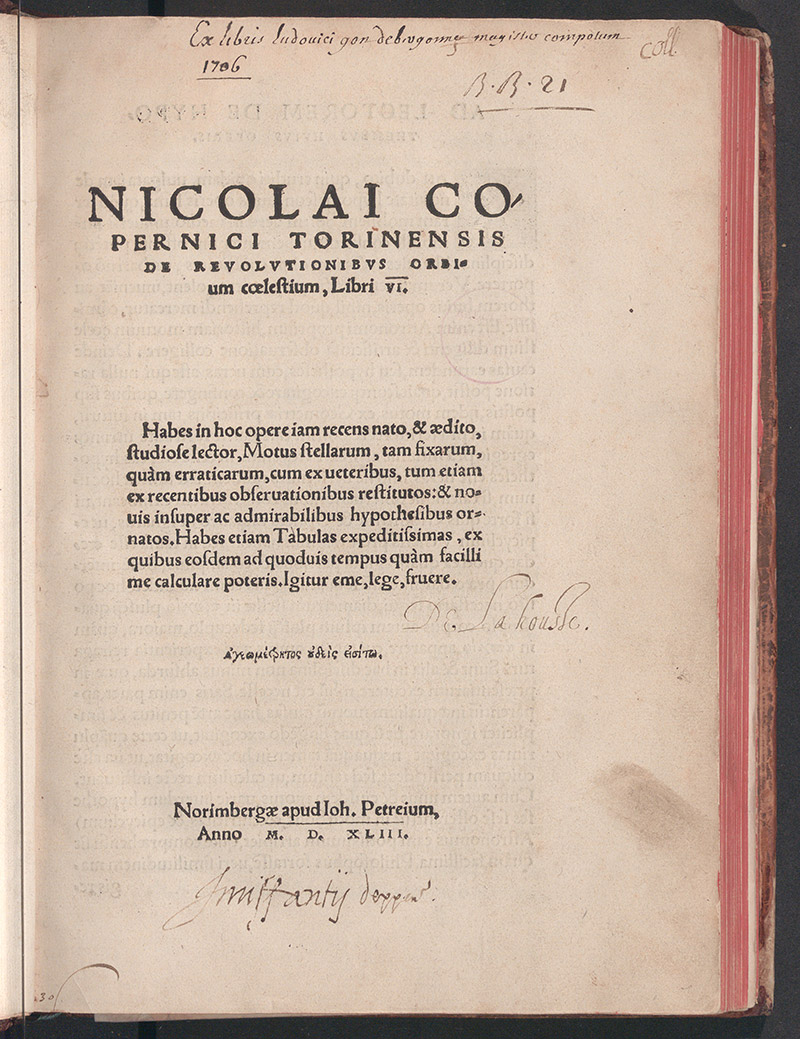De Revolutionibus (1543)

- Title page.
- Nicolaus Copernicus (Mikołaj Kopernik) (1473-1543).
- Nicolai Copernici Torinensis de Revolutionibus orbium coelestium libri sex.
- Nuremberg: Johannes Petreius, 1543.
First published in Nuremberg in 1543, Nicolaus Copernicus’ Six Books on the Revolutions of the Celestial Spheres is one of the greatest landmarks in the history of astronomy: it made the notion of heliocentrism widely available. However, Copernicus had been able to publicize his conception of the universe in the form of a manuscript summary (Commentariolus) as early as 1514. News about the content of this manuscript must have reached the scholarly community at Nuremberg, including the German polymath Johann Schöner, who encouraged a young mathematician from Wittenberg, Georg Joachim Rheticus, to visit Copernicus at the cathedral in Frauenburg, the northernmost diocese in Poland. Additionally, Rheticus must have received encouragement for this trip from Johannes Petreius, a Nuremberg printer with a great reputation as a publisher of scientific books. In 1539, Rheticus set out for the long journey to the shores of the Baltic Sea, taking with him as a gift for Copernicus three bound volumes containing five scientific works, three of them published by Petreius.
Remarkably, Rheticus, a twenty-five year old professor from Wittenberg, the cradle of Lutheranism, became the pupil of Copernicus, the sixty-six year old Catholic canon at Frauenburg cathedral. Rheticus convinced his mentor that the manuscript of the De Revolutionibus should be published in the prestigious printing house of Johannes Petreius in Nuremberg. In 1542, Rheticus moved to Nuremberg to exercise maximum control over all aspects of printing, including the commission of the woodblocks for the 142 woodcuts of the book. Moreover, Copernicus periodically received a batch of printed sheets for correction as it is attested by emendations listed in an errata leaf issued for the first 146 folios of the book: Copernicus marked the same errors in his own autograph manuscript. By mid-October Rheticus had to leave Nuremberg to take a new position as professor at the University of Leipzig, delegating the task of proofreading to a learned pastor, Andreas Osiander, who, amazingly, wrote an anonymous preface undermining the assertiveness of the treatise: “these hypotheses need not be true not even probable.” While the book was completed by 20 April 1542, as recorded in a presentation copy autographed by Rheticus, Copernicus would only receive the final sheets for correction shortly before his death one month later.
In the manner of a clever marketing tool, the title page includes a summary of the book’s content:
Diligent reader, in this work, which has been recently created and published, you have the motions of the fixed stars and planets, as reconstructed according to ancient and recent observations, and, furthermore, as being embellished with new and admirable hypotheses. You also have the most useful tables, from which you will be able to calculate those motions as easily as possible at whatever time.
The printer added the encouraging words, “Buy, read, and enjoy”, followed by the well-known Greek motto that, according to legend, was engraved at the door of Plato’s Academy: “Let no one ignorant of geometry enter.”
This title page also bears three ownership inscriptions, transcribed here from top to bottom: Ex libris Ludovici Gon de Brugonne magistro compotum 1706 (retrieved by the master from the library of Ludovicus Gon de Brugonne in 1716); De Lahousse; and J[oha]nni Hantii deggens. There is also the old shelf mark, “B.B.21”, and one can still see the red stamp of the Radcliffe Observatory at Oxford.
Select Bibliography
- Copernicus, Nicolaus. 1992. Nicolaus Copernicus: Complete Works. Trans. Edward Rosen. 2 vols. Baltimore and London: The John Hopkins University Press.
- Gingerich, Owen. 1993. “The Master of the 1550 Radices: Jofrancus Offusius.” Journal for the Study of Astronomy 24 (4): 235-253.
- Gingerich, Owen. 2002. An Annotated Census of Copernicus’ De Revolutionibus (Nuremberg, 1543 and Basel, 1566). Leiden - Boston - Köln: Brill.
- Gingerich, Owen. 2004. The Book Nobody Read: Chasing the Revolutions of Nicolaus Copernicus. New York: Walker & Company.
- Harris, Neil. 2006. “De Revolutionibus in Bibliography: Analysing the Copernican Census.” The Library 7 (3): 320-329.
- Kuhn, Thomas S. 1957. The Copernican Revolution: Planetary Astronomy in the Development of Western Thought. Cambridge, Mass.: Harvard University Press.
- Rosen, Edward. 2008. “Copernicus, Nicholas.” In Complete Dictionary of Scientific Biography, Vol. 3 (digital edition). Detroit, MI: Charles Scribner’s Sons: 401-411.